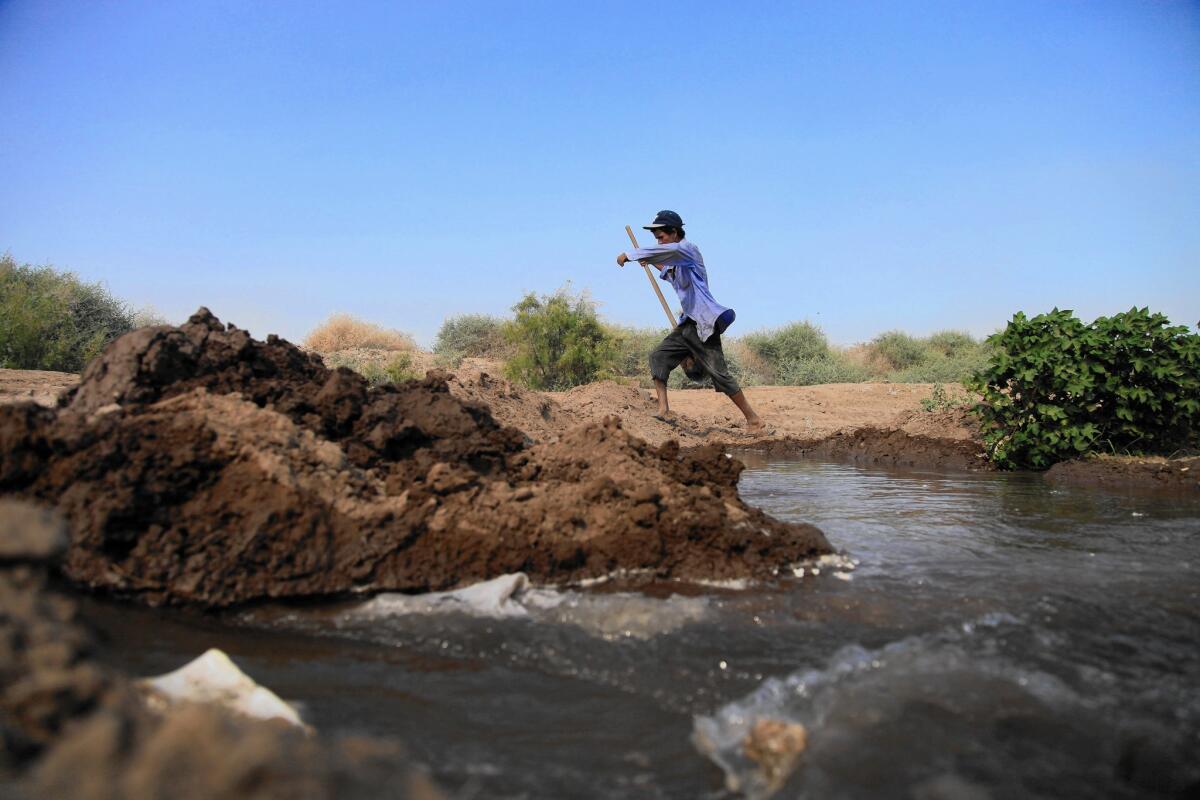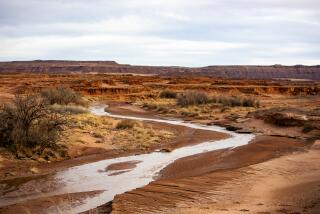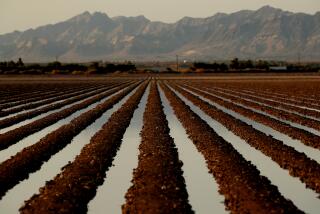Baja California farmers confront prospect of water shortage

- Share via
Blocks from the U.S. border on a recent afternoon, inside a packed auditorium, the farmers’ voices rose with their anxious questions. Water from the Colorado River has long been the lifeline for their fields of cotton, wheat and alfalfa, and they were learning about the probability of shortages.
What about their water rights? What about cities and industries in the state?
“The question is, will more water go to Tijuana and the coast?” asked Octavio Fierro Márquez. “We’re not against that, but we want certainty as to our rights. If they reduce [our deliveries], they’re taking away a right.”
There were no conclusive answers offered by the Comisión Internacional de Límites y Aguas, or CILA, the Mexican branch of a binational government boundary agency also known as the International Boundary and Water Commission. All officials could offer were estimates, possibilities and this certainty: If a shortage is declared on the Colorado River, Baja California and nearby Sonora can expect diminished deliveries.
With growing urgency, water managers are planning an array of measures aimed at stretching Baja California’s existing supply and creating new sources, including desalination plants, new wells and reservoirs, canal lining projects and improved irrigation techniques.
From San Quintin to the Guadalupe Valley to Mexicali, water has become a pressing topic for the state’s agricultural regions. “There practically has not been one day since I became secretary that the main topic has not been water,” said Manuel Valladolid, Baja California’s agriculture secretary.
More than half the state faces long-term drought conditions, with the most severely affected regions in the coastal corridor from Tijuana to Ensenada, according to a monthly drought monitor by Mexico’s National Water Commission. Tijuana relies on the river for 98% of its water supply. Ensenada, the only municipality in Baja California that does not receive water from the river, has been subject to rationing measures since 2014.
And yet, for many state residents, the gravity of the situation “hasn’t sunk in,” said Carlos de la Parra, a researcher at the Colegio de la Frontera Norte and president of a Tijuana citizens advisory committee on border issues. “The crisis that has hit California is still kind of like we’re watching a movie, and we really sympathize with the characters, and we say, ‘They’re suffering,’ and we’re not understanding that we’re part of this picture.”
As California last month implemented a mandatory 25% cut in urban water use, Baja California has yet to adopt similar statewide conservation measures. Only in recent weeks has the drought, or sequía, been a matter of broad public discussion.
At the tail end of the 1,450-mile Colorado River, Baja California has long depended on the river for its farms and cities; as in California, agriculture consumes the greatest share, about 85%. Supplemented by groundwater sources, Mexico’s allotment of 1.5 million acre-feet annually is the state’s chief source, crucial to the rippling wheat fields of the Mexicali Valley, the sprawling housing developments in Tijuana, factories in Tecate, and hotels and condominiums in Rosarito Beach.
In recent years, environmentalists have also sought a share of this water as they strive to restore the few remaining wetlands in the Colorado River Delta, a biologically rich region that is a stop on the Pacific Flyway, a key migration route for numerous bird species.
“Mexico may be at the bottom of the watershed, but we are part of the watershed,” said Roberto Salmón, Mexico’s CILA commissioner. “There is now greater understanding of this. People here are feeling they are part of the watershed, and the same thing is happening in the United States.”
In Mexico, the first effects of cutbacks on the Colorado River — a basin that links seven U.S. states with northern Mexico — are likely to be felt in the sprawling Mexicali Valley in the neighboring state of Sonora, where the smaller San Luis Valley also relies on deliveries of river water and a series of wells fed by seepage of river water.
Last month’s public meeting hosted by the boundary and water commission served as a wake-up call for many growers in Mexico’s Distrito de Riego 014, the irrigation district that covers 500,000 acres in Mexicali and part of Sonora. According to Mexico’s National Water Commission, close to 30% of the water deliveries are lost through evaporation or seepage, and upgraded infrastructure and improved management can go a long way.
“I don’t think that we’re ready,” said Manuel Hernández Gabilondo, owner of a Mexicali ice-making plant and head of the citizens advisory group to the boundary and water commission. “We need to generate long-term programs, and unfortunately our system is not geared to do that. Obviously our biggest concern, where we need to establish more programs, more efficiency, is in the farming community.”
More to Read
Sign up for Essential California
The most important California stories and recommendations in your inbox every morning.
You may occasionally receive promotional content from the Los Angeles Times.










